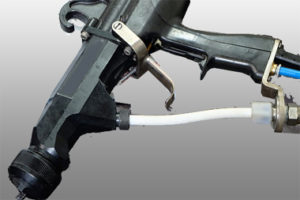In a recent judgment of the European Court in invalidity proceedings concerning a Community design, the court specified designer’s degree of freedom and thus also how different paint spray guns must be, which are restricted by applicable construction concepts and a saturation of the technical standard in design.
 Many design possibilities are limited by technical or constructional specifications. In the present case, the plaintiff Sata GmbH & Co. KG (Germany), which had filed a Community design application for spray guns for paints in 2011. The defendant Zhejiang Auarita Pneumatic Tools Co.Ltd (China) challenged this registration and applied for a declaration of invalidity due to its two earlier Community designs and one US design for the same goods registration.
Many design possibilities are limited by technical or constructional specifications. In the present case, the plaintiff Sata GmbH & Co. KG (Germany), which had filed a Community design application for spray guns for paints in 2011. The defendant Zhejiang Auarita Pneumatic Tools Co.Ltd (China) challenged this registration and applied for a declaration of invalidity due to its two earlier Community designs and one US design for the same goods registration.
How different can paint spray guns be?
The designs in question differ in small details:
- the use of the colours green and yellow
- the shape and position of the paint system at the bottom of the handle and nozzle
- the shape of the end pieces of the two screws (flattened vs. conical)
- the opening under the hook (square vs. circular)
- the shape of the handle (slimmer and slightly protruding vs. wider and flat)
The Board of Appeal of the EUIPO found those differences to be “not insignificant” but not sufficient to distinguish the overall impression of the contested design from the earlier designs. Therefore, on 12 July 2017 (“the contested decision”, R 914/2016-3), it declared the contested design invalid.
Designer’s degree of freedom limited by construction
The applicant Sata GmbH relied on two pleas in law against that decision before the Court of Justice of the European Union (CJEU). Mainly it accused the Board of Appeal of having wrongly decided that the contested design had not produced an overall impression different from that of the earlier design and therefore had no individual character. The degree of freedom of the designer was restricted by construction-specific specifications and also very limited by saturation of the state of the art.
This aspect is of great importance for the protectability of designs. According to previous case law, the more the designer’s freedom in developing a design is restricted, the more likely it is that small differences between the designs to be compared will suffice to justify protection. This makes the CJEU’s reasoning in this case all the more interesting.
The court precisely differentiated the Designer’s degree of freedom in the design of a paint pistol. Essential components of a paint spray gun are restricted: the handle, the trigger, the muzzle, the devices for adjusting the paint flow and the trigger movement as well as the connecting parts for the paint and the compressed air. Nevertheless, there is a high degree of design freedom with regard to the appearance (shape of the handle and spray head, weight) and their specific arrangement as well as the attachment (shape of the trigger, hook and devices for adjusting the paint flow).
Parts of this design freedom were actually exhausted in the contested design. But, for example, the slightly slimmer shape is not sufficiently distinct from the earlier designs for a consumer to perceive this in the overall impression, the CJEU ruled. Precisely because the appearance of all components could vary, the informed user had no reason to ignore the specific appearance in the overall impression – although he did not attach great importance to it due to its technical function.
Designer’s degree of freedom also limited by saturation of the technical state?
In this connection, the plaintiff also referred to a saturation of the technical standard, which additionally restricts the freedom of design. And the CJEU confirmed in its judgment an influence of the technical standard. According to the case law, it cannot be assumed that the saturation of the state of the art restricts the freedom of the designer, but it can make the user more sensitive to the differences between disputed designs. From this point of view, even minor differences in design may be sufficient to justify protection, which would not normally be sufficient. Before the Board of Appeal, however, the applicant did not provide sufficient evidence of saturation of the state of the art in the field of spray guns, nor did it provide any evidence of that.
In addition, since the CJEU found that there was considerable scope for the design of spray guns with regard to their individual characteristics and their specific arrangement, no saturation of the state of the art was to be assumed.
Therefore, the CJEU dismissed the action in its entirety.
In this context see also:
- Technical function determines the design: Exclusion from IP rights? (Docaram vs. CeramTec)
- When is the representation of a design sufficiently clear? ECJ ruled on Jägermeister
- Community design obviously ready for deletion
- Brexit (3): Community designs require a clone
Are you interested in design or industrial product protection?
Please take your chance and contact us. Our lawyers are experienced in trademark and patent law, national and international law.
Sources:
Picture:
Noordbizz /pixabay.com / CCO License








Leave a Reply